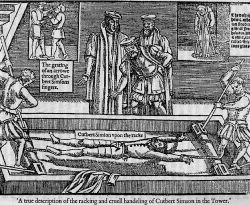 Cuthbert Simpson is reputed to be the first person to be “stretched” during the reign of Mary I – pulled in more than one direction at the same time while trying, in vain, to satisfy the simultaneous demands of his three interrogators.
Cuthbert Simpson is reputed to be the first person to be “stretched” during the reign of Mary I – pulled in more than one direction at the same time while trying, in vain, to satisfy the simultaneous demands of his three interrogators.
Being a middle manager in a large organisation feels rather like this – pulled in many directions trying to satisfy the insatiable appetites for improvement of Governance (quality), Operations (delivery) and Finance (productivity).
The critical-to-survival skill for the over-stretched middle manager is the ability to influence others – or rather three complementary influencing styles.
One dimension is vertical and strategic-tactical and requires using the organisational strategy to influence operational tactics; and to use front line feedback to influence future strategic decisions. This influencing dimension requires two complementary styles of behaviour: followership and leadership.
One dimension is horizontal and operational and requires influencing peer-middle-managers in other departpments. This requires yet a different style of leadership: collaboration.
The successful middle manager is able to switch influencing style as effortlessly as changing gear when driving. Select the wrong style at the wrong time and there is an unpleasant grating of teeth and possibly a painful career-grinding-to-a-halt experience.
So what do these three styles have to do with Improvement Science?
Taking the last point first. Middle managers are the lynch-pin on which whole system improvement depends. Whole system improvement is impossible without their commitment – just as a car without a working gearbox is just a heap of near useless junk. Whole system improvement needs middle managers who are skilled in the three styles of behaviour.
The most important style is collaboration – the ability to influence peers – because that is the key to the other two. Let us consider a small socioeconomic system that we all have experience of – the family. How difficult is it to manage children when the parent-figures do not get on with each other and who broadcast confusingly mixed messages? Almost impossible. The children learn quickly to play one off against the other and sit back and enjoy the spectacle. And as a child how difficult it is to manage the parent-figures when you are always fighting and arguing with your siblings and peers and competing with each other for attention? Almost impossible again. Children are much more effective in getting what they want when they learn how to work together.
The same is true in organisations. When influencing from-middle-to-strategic it is more effective to influence your peers and then work together to make the collective case; and when influencing from-middle-to-tactical it is more effective to influence your peers and then work together to set a clear and unambiguous expectations.
The key survival skill is the ability to influence your peers effectively and that means respect for their opinion, their knowledge, their skill and their time – and setting the same expectation of them. Collaboration requires trust; and trust requires respect; and respect is earned by example.
PS. It also helps a lot to be able to answer the question “Can you show us how?”
